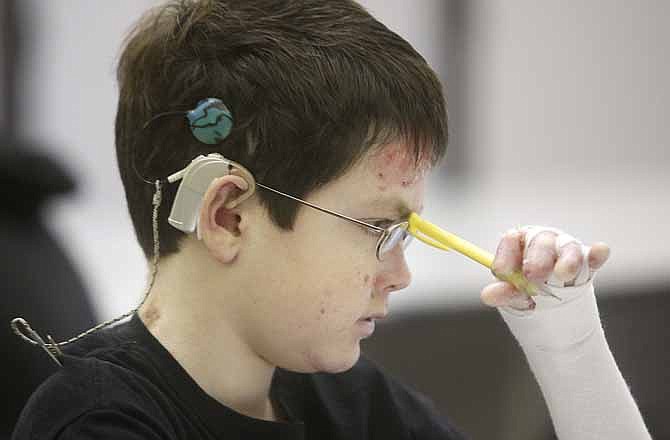MADISONVILLE, Ohio (AP) - Riding a bike, roller skating, or playing contact sports is unthinkable for a boy like Shane DiGiovanna.
But floating in air like an astronaut? Not a problem.
Shane, a 13-year-old Seven Hills student, has a rare skin disease called Epidermolysis Bullosa (EB), which makes his skin blister and tear easily. The Montgomery teen spends each day with 40 percent of his body wrapped in bandages.
He is careful in crowds and careful with his backpack, and can't open doors or his locker. Bumping into things wounds him.
Taking a bath and changing his bandages mean several hours of pain a day.
"It's like living with an active burn," said Dr. Richard Azizkhan, chief surgeon at Cincinnati Children's Hospital Medical Center's EB Center, which cares for nearly 300 adults and children like Shane.
There is no cure, though Shane has had more surgeries than he can count - more than 70. He jokes about being an FORP, "a frequent operating room person." Born deaf, Shane hears with two cochlear implants.
About one in 50,000 American children are born with the inherited disease. Some are called butterfly children, their skin as fragile as butterfly wings.
Shane thinks of himself in terms of a different kind of flight.
"My first word was 'airplane,'" Shane said. "Since I was four, I've wanted to go into space. Eventually, I realized that probably wouldn't be feasible with my skin, so I study everything about space."
With sights on astrophysics, he plans to become an engineer for NASA and help design spacecraft.
He's had a good head start.
At 11, Shane donned a "clean suit" - covering everything but his eyes- and went behind the scenes at the high-security NASA Jet Propulsion Lab in Pasadena, Calif., for an up-close look at a Mars rover under development. (The suit prevents anyone from tracking in dust and contaminants.)
Shane chatted and later corresponded with engineers there, sharing ideas for cushioning the rover's landing.
He reads voraciously, his mother Patsy says, everything from engineering blogs, to science magazines and to his favorite, The Economist.
More recently, Shane, his parents and sister, Meggie, toured Kennedy Space Center in Florida and spent a day flying in zero gravity. The November trip, funded by the Make a Wish Foundation, involved Zero G. Corp.'s special Boeing 727, which uses reserved airspace to fly a series of parabolic arc maneuvers. On the downward curves, everything in the plane is weightless for 30 seconds at a time.
Shane later shared photos of his floating adventure with his class. They asked how it felt to float and how he avoided injury.
He had extra padding under his flight suit, in addition to the normal padding on the plane's walls and floor.
"I did pretty well; my skin held up," he said. "I felt pretty comfortable floating."
Mostly, Shane "hovered" like a slow-moving Superman. But when the flight crew warned about the impending return of gravity, he positioned himself so he fell in a lying position.
Meggie, who's 11, made a better astronaut, he said, somersaulting through the air.
"I was hanging on for dear life - but in a fun way," he said to his classmates.
Azizkhan said the weightlessness was good for Shane.
"In a weightless environment, he probably would not be as injured," the surgeon said. "He was well-padded and he was not going to bang into things too much."
Students like Shane can go to school and do many things more common of teenagers, Azizkhan said. Thanks to medical advances and proper accommodations by family and school, patients like Shane can live far into their adult years.
"I have patients in their 50s," Azizkhan said. But he monitors skin cancer and blood infections, he said, which can be deadly.
Shane privately braces for his daily pain, his mother said. He doesn't let it affect school.
During his space talk with classmates, his throat was sore because its tissue tore the night before. Shane never considered rescheduling the presentation, Patsy said.
That's typical Shane, added Karen Glum, his science teacher.
"He's just a ball of enthusiasm and hope," Glum said. "This just blows us away, his ability to endure so much and to never, ever, ever complain."
Bill Waskowitz, head of the Middle School, said Shane's "spirit" and positive outlook inspire him.
"It sounds odd to say this, but he's comfortable in his own skin," Waskowitz said." Nothing is going to hold him back."
Information from: The Cincinnati Enquirer, http://www.enquirer.com

